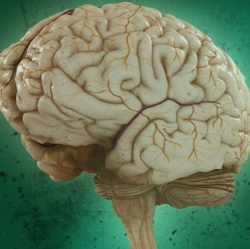
Sending pulses of electricity through the brain via implanted electrodes, a procedure known as deep brain stimulation, can relieve the symptoms of Parkinson’s and other movement disorders. The catch is that no one knows exactly why zapping the brain with electricity is so beneficial.
A study published today offers a potential explanation for the benefits seen in Parkinson’s disease: it keeps neurons from getting too “in sync.” If the finding bears out in further studies, it may be useful for making more sophisticated and effective devices that monitor brain activity and adjust stimulation automatically.
Healthy neurons don’t just fire randomly; there’s often a low-frequency rhythm that determines the timing of their activity, like a conductor setting the beat for a band. A growing number of studies suggest that synchronization has a role in many brain functions, from memory to perception to movement.
Researchers at the University of California, San Francisco, led by neurosurgeon Philip Starr, had previously found that this synchronization is abnormally high in the motor cortex of people with Parkinson’s disease compared to patients with dystonia (a different kind of movement disorder) or with epilepsy.
The same group has now found that deep brain stimulation lowers this excessive synchronization. Coralie de Hemptinne, one of the study’s authors, says that brain cells need a balance between coordination and independence; in Parkinson’s disease, motor cortex cells may have trouble disassociating their activity from the low-frequency rhythm in order to initiate movement. That could explain why people with the disease become stiff or frozen.
The study looked at patients undergoing deep brain surgery for their Parkinson’s disease, with electrodes implanted into brain structures that control movement. The study was limited to the time of surgery, but the group is now taking recordings from a few Parkinson’s patients who have permanent electrodes on the brain’s surface along with a deep brain stimulation implant, to see whether this connection persists.
The ultimate goal, de Hemptinne says, is to find a measurable signal that could be used to improve the therapy and automatically tune a deep brain stimulator. “Right now deep brain stimulation is working pretty well in movement disorders, but it’s still not optimal,” she says. Current stimulators must be adjusted for each patient through trial and error, and they stimulate the brain continuously.
